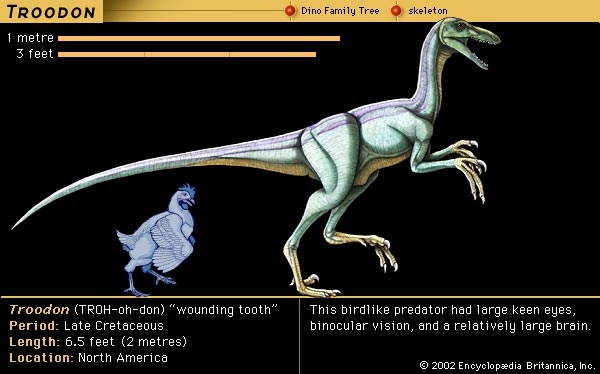saurischian
dinosaur order
 any member of one of the two major lineages of dinosaurs (dinosaur), including birds (bird) and all dinosaurs more closely related to birds than to Triceratops. In 1888 paleontologist Harry G. Seeley, a former student of Richard Owen (Owen, Sir Richard), separated dinosaurs into two groups based primarily on the form of the pelvis (though he also considered features of the skull and neck vertebrae). One group had hip bones arranged like those of typical reptiles, in which the pubis points down and forward; he named this group Saurischia (“lizard-hipped” or “reptile-hipped”). In the other group, a portion of the pubis points downward and backward, a condition superficially similar to that seen in birds; hence the name Ornithischia (ornithischian) (“bird-hipped”).
any member of one of the two major lineages of dinosaurs (dinosaur), including birds (bird) and all dinosaurs more closely related to birds than to Triceratops. In 1888 paleontologist Harry G. Seeley, a former student of Richard Owen (Owen, Sir Richard), separated dinosaurs into two groups based primarily on the form of the pelvis (though he also considered features of the skull and neck vertebrae). One group had hip bones arranged like those of typical reptiles, in which the pubis points down and forward; he named this group Saurischia (“lizard-hipped” or “reptile-hipped”). In the other group, a portion of the pubis points downward and backward, a condition superficially similar to that seen in birds; hence the name Ornithischia (ornithischian) (“bird-hipped”).The saurischians and ornithischians separated as lineages perhaps 235 million to 240 million years ago during the Middle Triassic Period (242 million to 227 million years ago). The first dinosaurs were small and bipedal; only later did they evolve immense size and a variety of adaptations for feeding and other functions. For reasons that are not well understood, the fossil record of saurischians in the Late Triassic (Triassic Period) (227 million to 206 million years ago) is much better than that of the ornithischians, though both groups were simultaneously beginning to diversify.
 The two main groups of saurischians are the theropods (theropod) and the sauropodomorphs (dinosaur). The theropods of the Mesozoic Era were all two-legged carnivores, from which birds evolved at least 144 million years ago (Late or Middle Jurassic Period).
The two main groups of saurischians are the theropods (theropod) and the sauropodomorphs (dinosaur). The theropods of the Mesozoic Era were all two-legged carnivores, from which birds evolved at least 144 million years ago (Late or Middle Jurassic Period). The other main saurischian group, the Sauropodomorpha, consisted mostly of quadrupedal herbivores, although their first members were relatively small and bipedal. Its most primitive members were the prosauropods, which included the plateosaurs (Plateosaurus). These creatures died out in the Early Jurassic Period (206 million to 180 million years ago), but they appear to have given rise to the larger and more specialized sauropods (sauropod), which remained one of the dominant dinosaur groups until the end of the Cretaceous Period 65 million years ago. The sauropods included the largest of all dinosaur species, among them Apatosaurus (formerly Brontosaurus), , (Diplodocus) and Brachiosaurus (brachiosaur). In general, the sauropods were distinguished by their huge size, long necks and tails, small heads, columnar legs, and heavy, solid limb bones.
The other main saurischian group, the Sauropodomorpha, consisted mostly of quadrupedal herbivores, although their first members were relatively small and bipedal. Its most primitive members were the prosauropods, which included the plateosaurs (Plateosaurus). These creatures died out in the Early Jurassic Period (206 million to 180 million years ago), but they appear to have given rise to the larger and more specialized sauropods (sauropod), which remained one of the dominant dinosaur groups until the end of the Cretaceous Period 65 million years ago. The sauropods included the largest of all dinosaur species, among them Apatosaurus (formerly Brontosaurus), , (Diplodocus) and Brachiosaurus (brachiosaur). In general, the sauropods were distinguished by their huge size, long necks and tails, small heads, columnar legs, and heavy, solid limb bones.- carbonate rock
- carbon black
- carbon cycle
- Carbondale
- carbon dioxide
- carbon disulfide
- carbon group element
- carbonic anhydrase
- Carboniferous Period
- Carbon in Earth's crust
- carbonium ion
- carbon monoxide
- carbon monoxide poisoning
- carbon steel
- carbon tetrachloride
- carbonyl group
- carborane
- carboxylic acid
- carbuncle
- carburetor
- carburizing
- Carcassonne
- carcharhinid
- Carchemish
- carcinogen